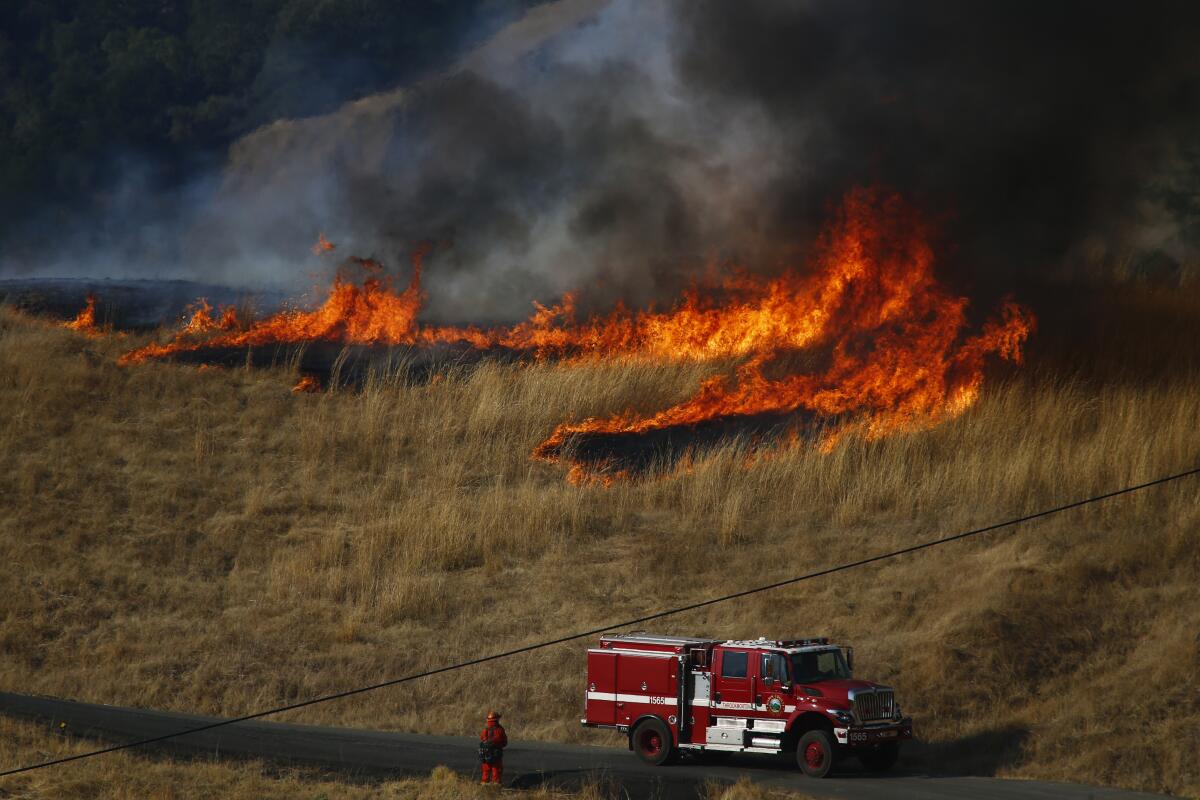Kincade fire stokes anxiety and a frightening sense of déjà vu among weary residents

- Share via
Santa Rosa — Laila Salonga watched the news closely, waiting for word on whether her neighborhood in Santa Rosa would be evacuated.
When her phone finally rang with an automated alert early Sunday morning, she didn’t second-guess it. She walked through her home, which doubles as a small residential care facility, and told the three women she cares for that they all needed to leave.
Two years ago, when the Tubbs fire tore through her nearby neighborhoods, Salonga was caught unprepared. This time, as the Kincade fire laid siege to California’s wine country, she was ready.
“But it doesn’t get easier,” Salonga said as she sat on a cot inside an evacuation center at the Sonoma County Fairgrounds, her three residents huddled quietly to her right. “One of my residents is partially blind, so navigating new places is really hard for her.”
As the Kincade fire continued to rage on Sunday, destroying at least 94 structures and forcing the evacuation of nearly 200,000 people, residents wrestled with anxiety, uncertainty and a frightening sense of déjà vu of wildfires past.
Many fled in the pitch darkness of night amid howling winds after Pacific Gas & Electric Co. blackouts left more than 2 million people across the region without power. Shelters were filled to capacity with fire refugees who worried about when they would be allowed back to their homes, jobs or schools.
Most vulnerable to the mounting stress were the young, old and infirm.
Kayla Williams, 26, her husband and two young boys left their Larkfield home just before dawn. Her 9-year-old was experiencing multiple panic attacks. Both boys cried at times, begging to return home.
As she and her family ate lunch at the Santa Rosa Veterans Memorial Auditorium, Williams kept her voice low, describing how her 4-year-old son asked her if they were going to live in a car permanently.
“I don’t know what to tell them,” Williams said. “It’s hard when us as adults are panicking and are trying to stay calm for them.”
Late Saturday, Heather Deghi and her 10-year-old daughter, Ava, could see the glow of the Kincade fire from their home in Windsor. Their neighborhood had been pitch-black for hours after power outages, but they didn’t lose electricity until moments before they had to evacuate at 4 a.m. Sunday.
Deghi oversees a care facility for disabled people in Windsor. When the sheriff shouted evacuation orders over a loudspeaker, Deghi and her family left with three clients whose families were not able to retrieve them.
Deghi’s first priority was to keep those in her care calm. Many of her clients live with mental illness such as schizophrenia and bipolar disorder. Major disruptions like this wildfire evacuation can profoundly affect those whose health relies on routine and familiarity, Deghi noted.
“I tried to take away from the severity and reality of it as much as I can,” said Deghi, who sought shelter at the Petaluma Veterans Memorial Building.
As the Kincade fire continued to rage, two new brush fires sparked on Sunday afternoon in Martinez and Lafayette, communities northeast of Oakland that were also affected by planned power outages. Forward progress of both blazes was later stopped, but not before three structures burned and the plumes of smoke stoked the anxiety of locals.
In nearby Orinda, Ryan Yeager charged medical equipment for his disabled daughter, Violet, at a city charging station. Violet, who uses a wheelchair, suffers from a disorder that requires a breathing device and a tube for nutrition. Yeager had ordered a $2,600 battery that was supposed to provide a few days of power, but it had not yet arrived.
“I don’t mind this as long as we are not having to evacuate,” Yeager said.
Many residents in the fire zone are reliving the trauma of October 2017, when the Tubbs fire destroyed or damaged more than 5,500 structures in Sonoma County.
Daniel Barcenas lost his home in that fire. He has since purchased another house on the edge of Coffey Park, a community of tract homes leveled by flames in 2017. That’s where he was with his 80-year-old grandmother and brother early Sunday morning, despite an evacuation order that came right up to their street, stopping short of their front door.
He is staying behind only because his brother, Eduardo, refused to leave. “He’s stubborn,“ Barcenas said.
Support our journalism
The Tubbs fire is still vivid in Barcenas’ mind: how the smoke was so thick and black that he could barely see, how traffic caused by fleeing residents choked the subdivision. At one point, he feared he would have to get out of the car and carry his grandmother to safety. Explosions provided the only source of light.
This time around, Barcenas and his brother sat on the back porch as a foreboding wind whipped around them.
“It’s like what it must have been like to survive the Titanic,” Barcenas said, “and have to go through it all again.”
Times staff writers Maura Dolan and Melody Gutierrez contributed to this report.
More to Read
Sign up for Essential California
The most important California stories and recommendations in your inbox every morning.
You may occasionally receive promotional content from the Los Angeles Times.














